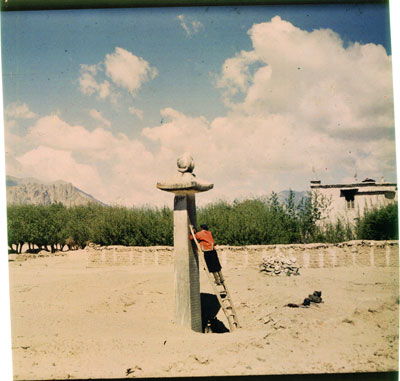
BMR.6.8.242 (Transparency colour)


BMR.6.8.242 (Transparency colour)

Hugh E. Richardson
Hugh Richardson
1948-50
Lhasa Area > Karcung
BMR.6.8.242
60 x 90 mm
Transparency Colour
Hugh E. Richardson
Technical Information - The cameras used to take this collection of colour slides (Dufay colour) were a Zeiss Super Ikonta and a Reflex Korelle. [KC 09/10/2006]
Manual Catalogues - Typewritten handlist entitled 'Hugh Richardson Collection, The British Museum. Photographs taken between 1936-50. Cameras: Zeiss Super Ikonta, Reflex Korelle. 300 colour slides (Dufay colour); copies made Jan. 1995.
[no.] 242. Karchung pillar with inscription, recording achievements of Tride Songtsen and his predecessors. The pillar was discovered near Gongkar by the Kagyu Lama Dechen Chokhor Rinpoche.' [KC 11/10/2006]
Other Information - History: Hugh Richardson discusses the history and significance of the pillar at Karcung in A Corpus of Early Tibetan Inscriptions , 1985, Royal Asiatic Society, James G. Forlong Series, No. xxxix, Royal Asiatic Society, pp. 72-81. "The pillar stands outside a small temple near the village of Ra-ma-sgang on the south bank of the Skyid-chu about two miles south-west of Lhasa. It records the renewal by Khri Lde-srong-brtsan of his father's vow to maintain the Buddhist faith ... The present-day temple is very small and neglected but it stands inside an extensive area bounded by four large ancient mchod-rten which show traces of having been covered by tiles of the colour appropriate to their position as are those at bSam-yas. A great accumulation of sand, which made it impossible to see whether there were the remains of other buildings, had covered the stone pillar ... I had enough of the sand cleared away to be able to copy the whole text; and some time later I was able also to clear the base on which the pillar stands and which was seen to be a massive block of stone carved with a pattern of mountains in the Chinese style ... Inside the courtyard of the little temple were a stone capital, similar to that on the pillar, and the remains of what appeared to be the base of another pillar which may be buried in the sand. ... " (p. 72) [KC 21/9/2006]
For Citation use:
The Tibet Album.
"Richardson's orderly copying the Karcung inscription"
05 Dec. 2006. The British Museum.
<http://tibet.prm.ox.ac.uk/photo_BMR.6.8.242.html>.
For more information about photographic usage or to order prints, please visit the The British Museum.
© The British Museum